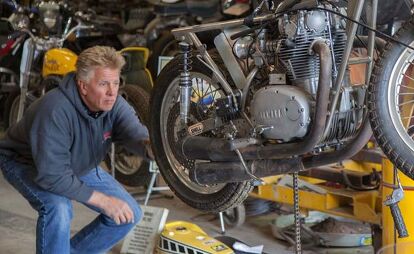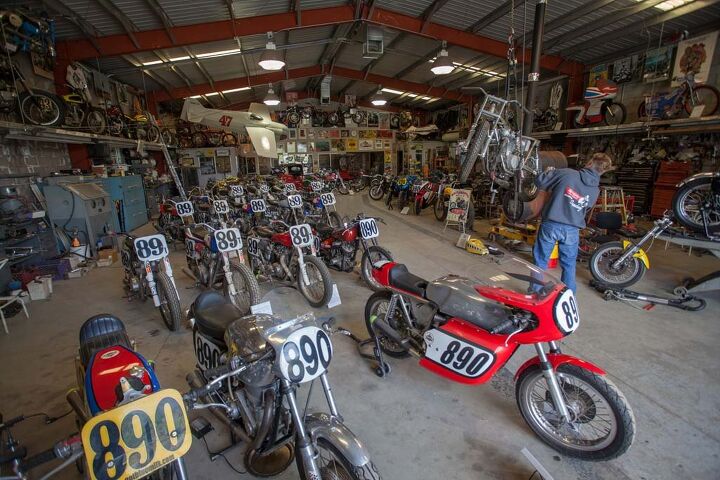Gary Davis: Motorcycle Jumping Pioneer Sells Collection
Evel Knievel rival and Hollywood stuntman empties garage
Most days, there are more than 2000 ads for motorcycles on the San Francisco-area Craigslist and probably a similarly large number advertised near any major population center. The odds of any one of these ads attracting much attention are pretty small. But when a certain for-sale ad appeared on the Sacramento list, it was different – very different.
The ad went viral and generated calls from all over the US, from Japan, Australia, New Zealand and even Russia. The reason: rather than beginning with a yawner like “86 KLR 600 – Runs Strong,” this ad opened, “Vintage Motorcycle Collection… All or Part … ” and included names ranging from Triumph to Trackmaster, Dick Mann to Wayne Rainey. It concluded simply, ” … way too many to list. Gary.”
So who’s Gary? And why’s he got so many bikes?
To answer the second question first, Gary Davis has a 10,000-square-foot man-cave filled with over 200 motorcycles because he was fortunate enough to make a pile of money in the movies and could afford to indulge his passion for race bikes, particularly dirt-trackers. His start, however, was less auspicious. In fact, he didn’t take up racing until he was in college at Arizona State in the early ’70s, studying electronic engineering with a minor in physics. Soon, though, he was into motorcycles in a major way, earning tuition money as a Honda mechanic and by jumping a motorcycle over cars.
“We just traveled around;” says Davis, “with my partner, Rex Blackwell, we’d go to different fairs and would both jump, crossing in the air over the cars. But our most consistent bookings were at drag races, with the hot-rod guys. Each weekend we would be in a different city and would set up our ramps and jump during the break.”
In all, Davis has made 326 public motorcycle jumps and never crashed once. He credits this consistent success to his physics background, “which enabled me to set up my ramps correctly and get my speed right.”
Take-off speed is critical because the margin for error is not large – too slow and one has a hard set-down on the flat first 10 feet of the down ramp; too fast and the jumper overshoots the ramp for an even harder landing. Davis’ secret? “I had two speedometers, one on the front wheel and one on the back, so if they both said I’m doing 85, I probably am.” he recalls. Although Davis tried to convince the other jumpers to use a speedometer, none would.
On his third jump, at Ontario Motor Speedway, Davis soared over 21 cars, beating the previous world record of 19 set by Evel Knievel the year before at the same event, the Miller 500. The ensuing notoriety became Davis’s entre to a career in the movies as a stunt rider, then coordinator, and finally stunt director.
His first job, in 1973, was as the stunt double for actor Sam Elliott, who played Knievel in a TV biopic about the legendary daredevil. Three years later he was the stunt double for Knievel himself, who starred in the movie Viva Knievel. From the DVD cover: “Motorcycle stuntman Evel Knievel is offered a fortune to perform in Mexico. What Evel doesn’t know it that they’re planning to kill him and use his body to ship cocaine into the U.S.” You get the idea.
Gary Davis and Evel Knievel
Gary Davis and Evel Knievel were rivals at first but gradually became friends over the years their careers intertwined. Knievel, senior to Davis by 13 years, was top dog, while Davis was the upstart challenger. In the end, Knievel (who died in 2007) helped Davis’s career, and Davis helped Knievel’s family.
Here’s how Davis tells it (slightly edited):
In 1973, CBS and Viacom were doing a pilot for a series called “Evel Knievel” with a young actor Sam Elliott playing Knievel. They couldn’t find a Hollywood stuntman to do what they wanted, which was to jump ramp to ramp, all in one shot, while they blow up both ramps. They just called me out of the blue and asked me if I’d be willing to try that. It sounded kind’a like fun.” [Blew up both ramps?] Yes, and the down ramp blew just when I was over it so I landed in all the rubble and flame. It was a hard landing.
But what I didn’t know – we were rivals at the time and had never spoken personally – was that Evel had found out they’d hired me to do the stunt, and he went crazy and took back half his stuff from the company. We didn’t expect him to be present at the filming, of course, but he’d come in secretly and was watching the whole thing, watching me do my jump. After the jump, I was done for the day and went back to the hotel. Later, at some point Evel got on the PA system and told the people that they had just witnessed one of the greatest motorcycle feats they would ever witness in their lives. Now, I didn’t hear this personally, but the crew members and Sam Elliott came and told me he had said that.
We still never spoke until some years later when Evel crashed in London. He called me at my house at three in the morning and said, ‘Gary. This is Evel.’ I said, “Who is this? I’m sleeping.” ‘Gary, you gotta come to London, take my place, and finish my European tour for me.’ From then on we were associates, friends.
I helped him raise his son, Robbie. Robbie would run away from home in Butte, Montana, and show up on my doorstep in Southern California. Robbie is jumper now, too. Kelly, Evel’s oldest son, runs the Evel Knievel Enterprises to this day. They still market that name, as well they should. It’s possibly the most recognized name in the world. It’s certainly in the top two or three, if not the most.
Gary Davis’s credits include Terminator 2, Independence Day, Amazing Spiderman, and most recently, Spiderman 2. In 2000, after 30 years in Los Angeles, Davis moved to Auburn, California, not far from where he grew up in Loomis, to a house on a hill overlooking his humongous garage and a small lake in the center of a dirt-track oval. Not bad.
Rows and rows of motorcycles, nearly every one sporting a number plate with Davis’s “89” or “890,” cover the floor of the garage, giving the visitor the impression of entering a mono-theme museum. Motorcycles aren’t just on the floor, they also perch high on shelves along the walls, some adorned with memorabilia from the movies in which they appeared. On the day we visited, Davis was wrenching on an early ’80s Yamaha OU-750, built by Shell Thuet for Kenny Roberts, converting it from road-race trim back to the original dirt-tracker condition when he bought it.
Davis doesn’t consider his assemblage of bikes a ‘collection’ per se. “I’ve always had a lot of movie bikes,” he says, “ones that I’ve used in films. Then I eventually got excited about buying back some of my old racers, and in the process of tracking them down, I’d stumble on some cool finds – Dick Mann bikes, Kenny Roberts bikes. I just bought them to have around me for fun.”
Wait! – there’s more: “I got the crazy idea when I moved up here to recreate the front line of bikes appearing in photos in my high school yearbook – the Honda 305 Scramblers, Superhawks, Hodakas – the bikes kids rode to school at that time. Well, I had all those bikes here for a while and, well, it’s gotten out of control. I had 247 motorcycles, and maybe that’s too many.”
Perhaps this was the eureka moment that led to the Craigslist ad. In any case, the number of bikes has dropped by a hundred or so. In fact, we didn’t arrive a moment too soon. The day before, Dana Mecum of Mecum Auctions spent a couple of hours looking around, then transferred an undisclosed sum (we didn’t dare to ask) directly to Davis’s bank account. Nineteen of the best bikes will be transferred from Davis’s garage to Mecum’s garage in the next few days, including the Kenny Roberts OU-750, assuming he gets it back together in time.
Not everything will go. Gary will keep his jump bikes and movie bikes and other items of very personal significance. And maybe not everything will sell. For the future, though, it’s hard to imagine Gary Davis – he’s only 63 years old – not having a few vintage bikes around for racing at AHRMA events, and not having a few more motorcycles around him – just for fun.
More by Bob Stokstad












































































Comments
Join the conversation
The guy also knows his way around a flat track, be good to see him out there with Eddie Mulder and company again. He was also the better jumper. It's oft been said, Evel was a good jumper, not such a good lander.
The plural form of Harley is Harleys, not Harley's